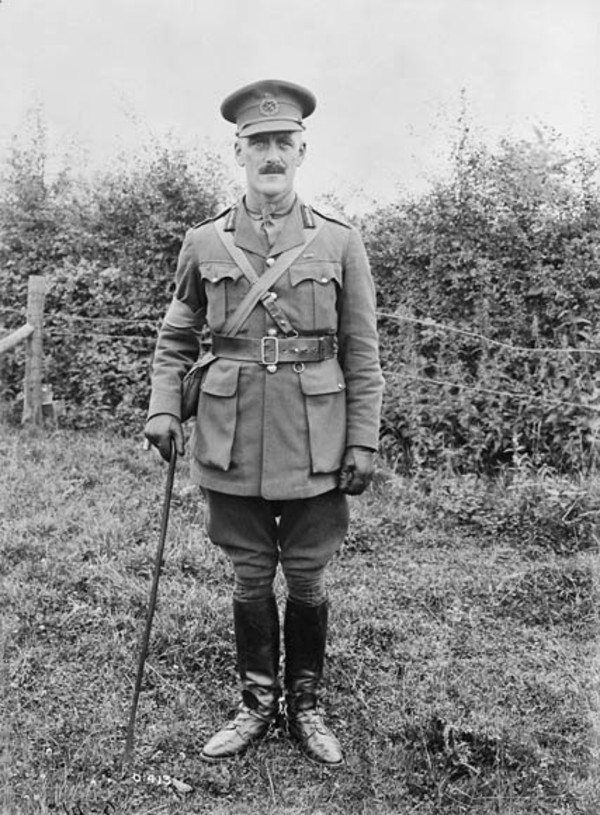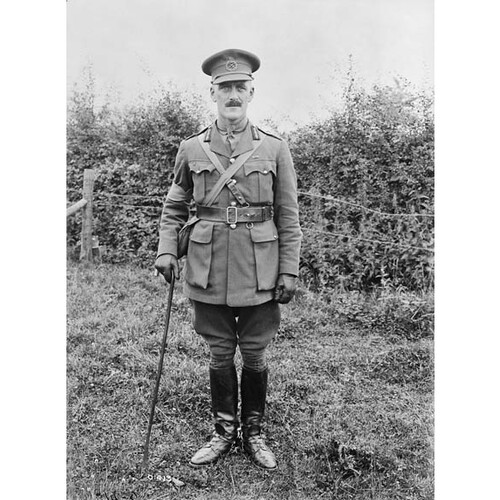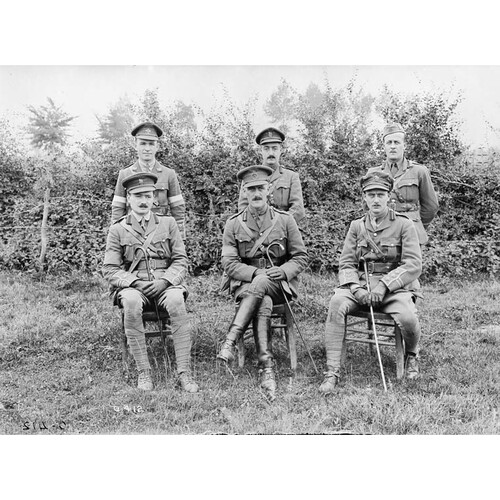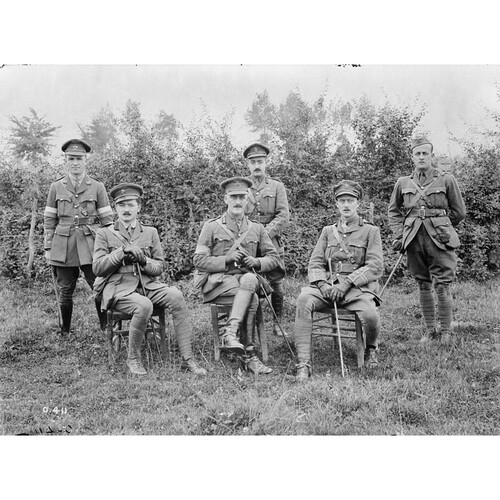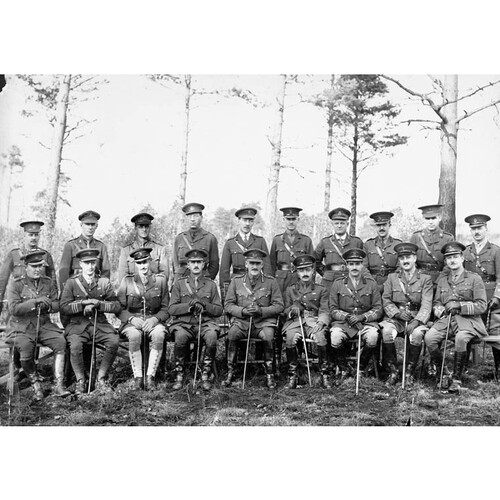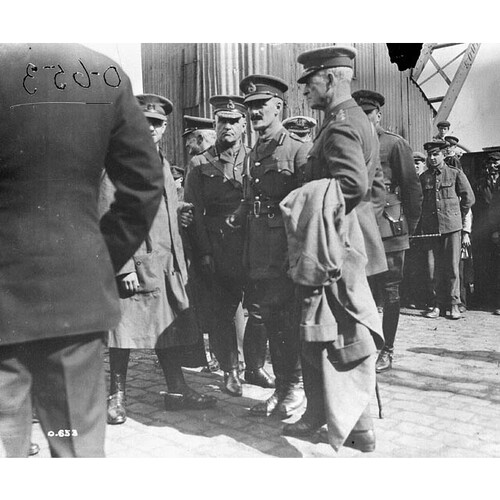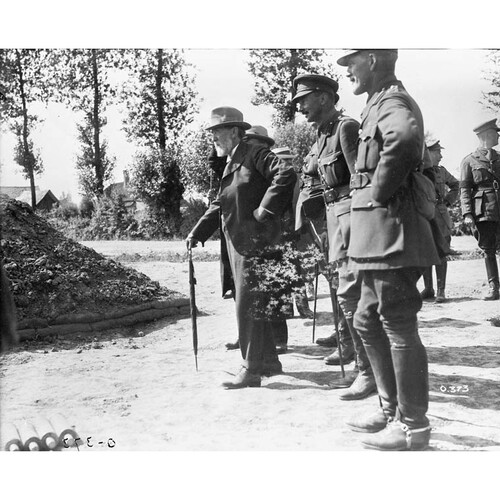HUGHES, GARNET BURK, civil engineer, militia and army officer, and businessman; b. 22 April 1880 in Toronto, son of Samuel Hughes* and Mary Emily Burk; m. 15 Oct. 1910 Elizabeth Irene Bayliss Newling (29 April 1882–19 Nov. 1928) in Victoria, and they had one son; d. 12 April 1937 in Toronto.
When Garnet B. Hughes was five years old, his father gave up his teaching position in Toronto to run a Conservative newspaper in Lindsay. Garnet attended classes there, and during his high-school years he trained with the 45th (West Durham) Battalion of Infantry. In 1898 he was accepted into the Royal Military College of Canada (RMC) in Kingston with the highest entrance mark. His father, who had been promoted lieutenant-colonel of the 45th Battalion the year before, undoubtedly encouraged Garnet’s military training, but later correspondence between the two suggests that paternal direction was not heavy-handed. In reply to a letter from Garnet, who had referred to “flogging” his own son, the elder Hughes would write in 1919: “I never was an advocate of it.… I never believed in breaking the will of anybody in youth. Guide them along right lines, firm and kind, and when a clash comes, quietly turn the subject.” At the RMC Garnet earned top grades and served as battalion sergeant-major in his final year. Upon graduation in 1901 he received the Governor General’s Medal for academic achievement and the Sword of Honour for outstanding performance. He was placed on the reserve of officers as a lieutenant of engineers.
Such training usually led directly to a post with the British army, but Hughes turned down a commission with the Royal Engineers at Woolwich (London). It may be that his father influenced his decision, but another factor was likely what the Globe (26 June 1900) called a new “esprit de corps” among RMC graduates: “They seem to have imbibed an aversion to conditions in the Imperial army, and are nearly all going forward to courses in engineering and mining.” Hughes was employed by the Canadian Northern Railway (CNR) and worked in Ontario, Quebec, and the western provinces. The CNR was managed and promoted by William Mackenzie* and Donald Mann. Mackenzie and Mann also had contracts to build reservoirs in Mexico, and Hughes assisted with these. In 1909 or 1910 he relocated to Victoria; according to the 1910–11 city directory he was still employed by Mackenzie and Mann. He subsequently served as chief engineer for projects undertaken by the federal Department of Public Works on the west coast. There he joined the militia as a part-time officer, and he also met Elizabeth Irene Bayliss Newling, who had immigrated from England with her mother in 1890. They married in October 1910, and three years later Samuel Harvey Shirecliffe Hughes* would be born.
Since 1892 the elder Samuel Hughes had been the House of Commons representative for the Ontario riding of Victoria North (Victoria and Haliburton as of 1903). In October 1911 he was named minister of militia and defence, and two years later he authorized the formation of the 50th Regiment (Gordon Highlanders of Canada) in British Columbia’s capital. Garnet played an active role in the birth of the unit and was made second in command to Lieutenant-Colonel Arthur William Currie. When war broke out in August 1914 and the minister took charge of preparing the Canadian Expeditionary Force (CEF), both young men benefited from their connections. Garnet was of course aided by his father; within a few months of enlisting he was a major, but the rank was not completely out of line with his credentials. It was on Garnet’s recommendation that the minister had offered Currie command of the 2nd (Provisional) Infantry Brigade of the Canadian Division (which would become the 1st Canadian Division in May 1915). When Currie hesitated because of financial problems, Garnet persuaded him to accept. This decision was particularly important because the appointment would prove to be one of the best of Sam Hughes’s improvised actions: Currie would go on to lead the 1st Division and later command the Canadian Corps. According to historian A. M. J. Hyatt, Currie was also lucky to run into his friend when he arrived on 1 Sept. 1914 at Valcartier, Que., from where the CEF would embark for England. Hughes helped him amid the confusion and shared his tent as both prepared to join their units. Hughes, holding the rank of brigade-major, was on his way to assist Richard Ernest William Turner*, who was in charge of the 3rd Infantry Brigade and would become a brigadier-general the following March.
Under the command of Lieutenant-General Edwin Alfred Hervey Alderson*, the Canadian Division went to France in early 1915. The first significant engagement for Turner’s men was in April at Ypres (Ieper), Belgium, where the Germans introduced a new weapon: chlorine gas. The fog of war was particularly thick as Turner and Hughes tried to decipher conflicting reports at their headquarters. They did not do well. Lieutenant-Colonel Currie demonstrated a more successful reading of the battlefield situation and expressed frustration that his 2nd Brigade had not received better support from the 3rd. In both contemporary and later evaluations of the circumstances, some analysts would be more understanding than others of the difficulties faced by Turner and Hughes. Currie, however, had developed a negative impression of their abilities, which would affect relations for the rest of the war.
Despite this rough introduction, Hughes, along with many fellow officers mentored by the more experienced British regular force commanders, gained skills. His apprenticeship was recognized with promotions and honours: he had been mentioned in dispatches in May 1915 and was awarded the Distinguished Service Order the following month. In November he was put in charge of the 1st Infantry Brigade, and on 4 December he was made a temporary brigadier-general, one of the youngest in the British army. Hughes would be twice more mentioned in dispatches, and named a companion of the Order of St Michael and St George in January 1917 and a companion of the Order of the Bath in June 1918.
To some degree Hughes owed these honours and advancements to the fact that he was the son of the minister of militia and defence. His pedigree was not always an asset, however: he was passed over for positions, partly because of increasing animosity between his father and his friend Arthur Currie. The Canadian Corps had been formed in September 1915 and Currie, now a major-general, had been given command of the 1st Division. He opposed the minister’s demand that his son be placed in charge of a brigade in the 2nd Division, which had been established earlier that year with Turner (now also a major-general) at its head. Currie wanted the post to go to an experienced leader, and he strongly resented political interference in military appointments. Neither he nor Lieutenant-General Alderson, the Corps commander, felt that Garnet Hughes was suitable. Alderson, who did not like the idea of Hughes and Turner working together again, resolved the dispute by saying that he wanted Hughes to have a role inside the 1st Division, where he would be under Currie’s supervision. Hughes took over the 1st Infantry Brigade, but Currie was not happy about it. He explained his reasons directly to his friend, which reduced tensions between the two, but reconciliation with the elder Hughes would be impossible.
In May 1916 Alderson was replaced by Lieutenant-General Sir Julian Hedworth George Byng as British commander of the Canadian Corps. In a comment that reflected the rising nationalism spreading throughout the Canadian units, as well as appreciation for the trained British officers’ guidance, in July Hughes would tell his father’s friend Sir William Maxwell Aitken* (the future Lord Beaverbrook) that Byng “has made himself a favourite with all who have known him. We really have a Canadian Corps now, and I am not sure that he is not the most loyal Canadian of us all.” A 3rd Canadian Division was established during the winter of 1915–16 and a 4th in April. They were put under the orders of Major-General Malcolm Smith Mercer* and Major-General David Watson* respectively. Mercer was killed in June. Sir Sam (he had been knighted in August the previous year) immediately telegrammed an order to “give Garnet 3rd Division,” which was refused by Byng. The post went instead to Major-General Louis James Lipsett*. One of the minister’s final acts in office (he was forced to resign his post in November) was to authorize the formation of a 5th Canadian Division, which he said his son would lead into battle. In February 1917 Garnet Hughes was promoted major-general and put in charge of the new division. In June, while he was training his men in England, it was announced that Currie would replace Byng as leader of the Canadian Corps. This succession left a vacancy for command of the 1st Division. In private correspondence Currie had seemed to give the younger Hughes hope that he would receive the post, praising the performance of his 1st Infantry Brigade during the recent victory at Vimy as well as his preparation of the 5th Division. Prime Minister Sir Robert Laird Borden and Sir George Halsey Perley, the minister of the overseas military forces of Canada, decided it would be best to give Hughes the promotion as a way to calm down Sir Sam, who, although he was no longer in cabinet, remained a problem in the House of Commons. Such a thinly veiled political consideration, along with memories of Garnet’s mistake during the battle of Ypres, immediately elicited Currie’s veto. The post went to the much more experienced Major-General Archibald Cameron Macdonell*. Currie’s friendship with the younger Hughes was now very strained and, as Currie would later allege, a heated argument ended with Hughes shouting “I will get even with you before I am finished with you.” Shortly after Macdonell’s appointment, scandalous statements circulated regarding Currie’s pre-war finances, and relations deteriorated further between Currie and the Hughes family.
Major-General Hughes’s chances to lead the 5th Division in action ended abruptly a year after it was formed. Sir Sam and Borden had both intended that it fight as a unit, but Currie, who was closer to the growing problem of casualties, had the final say when he convinced Sir Sam’s replacement, Sir Albert Edward Kemp*, that maintaining the strength of four divisions in the field was a better tactic than adding a new one. As soon as the 5th Division arrived in France, Hughes received orders to demobilize and transfer his men to other units as reinforcements. He was shocked and his father furious. After obeying the order, the aggrieved Hughes asked Kemp to persuade Currie to remove Lipsett from the 3rd Division, which would open up the latter’s command post. The reluctant Kemp was relieved when the prime minister rejected the proposal. In Sir Sam’s opinion a better commander than Currie would have minimized the number killed and wounded, and thus there would be no need to break up the 5th Division and deny his son the chance to return to battle. Currie had little sympathy, stating in private correspondence in August, “Garnet has been an exceedingly lucky officer, beginning the war as a major with practically no experience whatever in military matters and, after spending eighteen months in France he found himself a Major General with a CB, a CMG, and a DSO.” Before the war ended Hughes was offered the position of managing director of the British Cellulose and Chemical Manufacturing Company and thus made the decision to remain in England, which suited his wife, who had moved there with young Samuel early in the war.
Bad blood between Sir Sam Hughes and Sir Arthur Currie continued to circulate after the war. As the former minister told his son, “I created him on your recommendation; made him what he is; covered his blunders; hid his cowardice and his reward for my decency was giving it to you in the neck and, as far as possible, to me.” He told Garnet that he had heard from many people that the 5th Division had been the best. Publicly, he criticized Currie’s performance and linked it to the high number of casualties in the final months of the conflict, stating in parliament in March 1919 that the celebrated war hero had unnecessarily sacrificed soldiers’ lives. In a letter to a friend Currie fumed that Sir Sam’s only thought regarding the huge loss of Canadian soldiers was that it required more reinforcements and the breaking up of the new unit: “As his son commanded the 5th Division, a division created solely that his son might be made a Major General, discloses to everyone the reason for Sir Sam’s animosity.” Even after the elder Hughes died in 1921, negative references to Currie continued to surface. In 1927 a newspaper published an article on Sir Sam’s opinion that Currie was a butcher. Currie blamed Garnet Hughes for what he called a “smear campaign.” The result was a famous libel trial the following spring, which Currie won. Yet, despite everything, after 1928 the two veterans continued to share a genuine affection, and Hughes even acted as a pall-bearer at Currie’s funeral in 1933.
Most of Hughes’s post-war career, when he was not writing his version of the history of the 5th Division (it was never published), was devoted to industrial and engineering pursuits. In 1920 he left the British Cellulose and Chemical Manufacturing Company to set up his own engineering consulting practice in London. He worked on projects in Canada, England, and Mexico, and for a British construction firm in Greece. His domestic life was less successful: the marriage broke down, and his wife, son, and mother-in-law moved to a village in Buckinghamshire. Hughes saw his son regularly, and in his memoirs the younger Samuel would describe him as a “warm and … very conscientious father.” After Elizabeth Hughes died suddenly in 1928, Garnet and 15-year-old Samuel moved to Toronto, where Garnet continued his career and served as honorary colonel of the Toronto Scottish Regiment from 1931 until his death. Upon returning from a business trip in April 1937 he was admitted to hospital with acute appendicitis. Four days after surgery, he died of peritonitis at age 56. He was buried alongside his parents in Riverside Cemetery, Lindsay.
Garnet B. Hughes had been fortunate to be guided by two of the most influential members of the Canadian war effort – his father and his old friend. Each had tremendous energy and a desire to serve Canada, and each was very much aware of his own interests and reputation. Garnet shared these virtues and faults, and when the two strong characters collided, few were more affected than he.
AO, RG 80-8-0-1713, no.003348. LAC, R3880-0-9; R4276-0-X; R6113-0-X; RG 150, Acc. 1992–93/166, box 4590-26. Globe and Mail, 13 April 1937. R. C. Brown, “Hughes, Sir Samuel,” in Dictionary of Canadian biography: www.biographi.ca/en/bio/hughes_samuel_15E.html (consulted 30 Jan. 2018). Canadian who’s who, 1936/37. Tim Cook, At the sharp end: Canadians fighting the Great War, 1914–1916 (Toronto, 2007); The madman and the butcher: the sensational wars of Sam Hughes and General Arthur Currie (Toronto, 2010); No place to run: the Canadian Corps and gas warfare in the First World War (Vancouver and Toronto, 1999). D. E. Delaney, “Mentoring the Canadian Corps: imperial officers and the Canadian Expeditionary Force, 1914–1918,” Journal of Military Hist. (Lexington, Va), 77 (July 2013): 931–53. Directory, Victoria, 1910/11. R. G. Haycock, Sam Hughes: the public career of a controversial Canadian, 1885–1916 (Waterloo, Ont., 1986). S. [H. S.] Hughes, Steering the course: a memoir (Montreal and Kingston, Ont., 2000). A. M. J. Hyatt, General Sir Arthur Currie: a military biography (Toronto, 1987). Andrew Iarocci, Shoestring soldiers: the 1st Canadian Division at war, 1914–1915 (Toronto and Buffalo, N.Y., 2008). Desmond Morton, A peculiar kind of politics: Canada’s overseas ministry in the First World War (Toronto, 1982). G. W. L. Nicholson, Canadian Expeditionary Force, 1914–1919: official history of the Canadian army in the First World War (Ottawa, 1962). The selected papers of Sir Arthur Currie: diaries, letters, and report to the ministry, 1917–1933, ed. M. O. Humphries (Waterloo, 2008). R. J. Sharpe, The last day, the last hour: the Currie libel trial ([Toronto], 1988).
Cite This Article
John MacFarlane, “HUGHES, GARNET BURK,” in Dictionary of Canadian Biography, vol. 16, University of Toronto/Université Laval, 2003–, accessed December 31, 2025, https://www.biographi.ca/en/bio/hughes_garnet_burk_16E.html.
The citation above shows the format for footnotes and endnotes according to the Chicago manual of style (16th edition). Information to be used in other citation formats:
| Permalink: | https://www.biographi.ca/en/bio/hughes_garnet_burk_16E.html |
| Author of Article: | John MacFarlane |
| Title of Article: | HUGHES, GARNET BURK |
| Publication Name: | Dictionary of Canadian Biography, vol. 16 |
| Publisher: | University of Toronto/Université Laval |
| Year of publication: | 2023 |
| Year of revision: | 2023 |
| Access Date: | December 31, 2025 |


